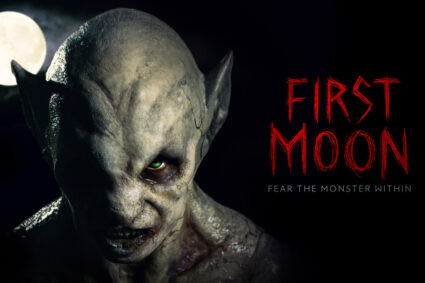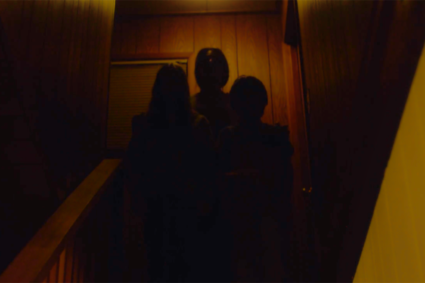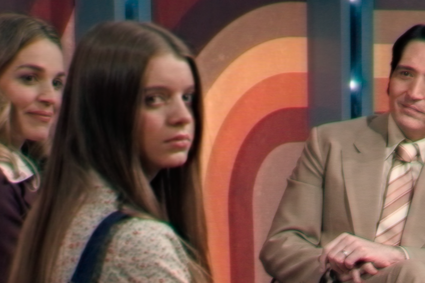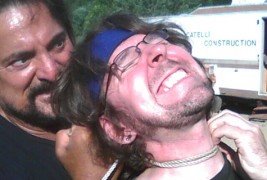
Independent filmmaker Jeremiah Kipp is on the cusp of becoming a household name in genre circles. His feature debut, THE SADIST, starring horror deity Tom Savini, is generating cyber-buzz worthy of horror and exploitation heavyweights. But this didn’t happen overnight. Kipp has served as second-unit or assistant director on several independent genre successes including I SELL THE DEAD and SATAN HATES YOU as well as the forthcoming TALES OF POE and his own short films showcase his exciting visual panache and true blue filmmaking bona fides. He’s a skilled auteur with a love for horror that includes stints writing for FANGORIA and SHOCK CINEMA as well as a close affiliation with red hot NYC-area independent genre stalwart Larry Fessenden and his Glass Eye Pix production company.
Ravenous Monster caught up with Jeremiah Kipp to discuss THE SADIST, his critically acclaimed short films, and what the future holds for this fast-rising fright filmmaker. Read on, Horror Fans…
RavMon: Tell us about THE SADIST. How did the opportunity to direct your first feature come to pass?
Jeremiah: Work begets work, and I was hired as director on THE SADIST based on the producers seeing my short film CONTACT. My previous short films went along the festival circuit, but I decided to put this one online so anyone could see it. I’m grateful to the blog-o-sphere for supporting the movie, and that’s a significant part of the reason I was able to work on THE SADIST. It’s also worth mentioning that I got brutally mugged and beaten up a block and a half from my house in January 2010, which got me to thinking that life is short and unpredictable. We have to seize every opportunity. I vowed to direct a feature that year, and within a few months, THE SADIST fell right into my lap.
RavMon: Tom Savini plays the titular character whose back story involves harrowing experiences in Iraq and Afghanistan. Is THE SADIST a horror flick wherein the war stuff is exposition, or do you elevate that material to make a statement about those conflicts?
Jeremiah: In ESCAPE FROM NEW YORK, they imply that Snake Plissken had legendary adventures long before the film begins by mentioning that he is a former war hero who flew the gulfire over Siberia. We suggest that the character Tom Savini plays had near-mythic experiences in Afghanistan and Iraq so brutal it pushed him over the edge. I don’t think THE SADIST makes any particular statement about the war in the Middle East, other than that war is madness and hell. Post-traumatic stress disorder morphed this particular troubled soul into a demon. John Rambo was a similar monster, only ours has given in to his deeper animal impulses.
RavMon: You’re clearly no stranger to the horror genre’s A-listers, but is there anything close to getting star struck when it comes to directing someone such as Savini?
Jeremiah: I remember watching DAWN OF THE DEAD when I was a little kid, and Savini was one of my early heroes. When you’re working with someone who’s been in the business as long as you’ve been alive, it’s wise to respect their level of experience. Now, it’s a known fact Tom Savini has a reputation for being “difficult” but in my experience that’s just a code word for wanting the shoot to be done right, with no bullshit. I called around, and people who met him at conventions said he could be a pain, but his previous directors all said he came to the set with high energy, enthusiastic and full of creative ideas. That was the Tom Savini I met on THE SADIST. I’m sure he would have walked all over me if I acted star-struck and wasn’t prepared, so the minute he showed up on set my director of photography and I showed him three minutes of footage we’d previously shot for the film, and he dug what he saw. He threw himself into the role, even volunteering to do his own stunts for the big climax, so we’re talking about a guy who goes above and beyond the call of duty if he believes in the cause.
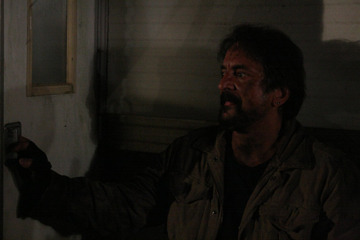
RavMon: You have a long list of second-unit directorial credits, including some well-known genre fare such as I SELL THE DEAD. How well has this experience prepared you for feature directing?
Jeremiah: If you work on enough sets, you get it hard-wired into your system and learn tricks from the good, the bad and the ugly. I SELL THE DEAD was one of the high points, working with Glenn McQuaid, Larry Fessenden and his Glass Eye Pix team, where they pride themselves in having high production value on low budgets. Along the way, you learn how to move the camera, how to work with actors, how to tell the story visually—but what I gained the most from movies like I SELL THE DEAD was a knowledge of the incredible stamina it takes to make a low-budget feature. The best advice is to buy the most comfortable pair of shoes you can find, because you’re on your feet every day for four weeks.
RavMon: Please tell us about CRESTFALLEN, your most recent short film.
Jeremiah: That project came about through a wonderful writer and producer named Russ Penning, who had a script based on some of the darker moments in his life. We decided to shoot out in Indiana with the help of our colleague, Marv Blauvelt at Muscle Wolf Productions. Marv put together the cast, crew and locations, and my cinematographer/editor Dominick Sivilli and I flew out from New York to make the picture. It’s an intense chamber piece about suicide. As the main character (played by Deneen Melody) cuts open her wrists, she grapples with a flood of memories. The film works as a testament to the strong performances, Dominick’s visual sensibilities, and Russ’s script, which gets to the heart of the matter. We didn’t judge any of the characters. They’re all fragile, all human…
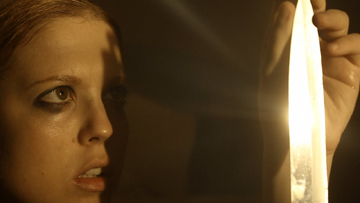
RavMon: CRESTFALLEN is a dichotomous film in several ways. It expresses serenity juxtaposed with anxiety, open spaces with enclosures, youth with age, companionship with isolation, life with death and back again. Deneen Melody’s character is beautiful, yet bloody. Your visual aesthetic is very muted and gritty, even the primary colors are autumnal. How does that choice buttress CRESTFALLEN’s themes and yin-yang motif?
Jeremiah: I greatly enjoy my collaborations with Dominick Sivilli, who shot and edited CRESTFALLEN and CONTACT. He also shot THE SADIST and would have edited it too if the producers had allowed his involvement. If you noticed the colors and the mood, you noticed Dominick’s work. He’s an intuitive artist, and when we work together, we don’t talk about the colors per se, we talk about the effect we want to have on the audience. That leads us to our visual choices. The “dichotomous” quality you speak of was found in the editing room, where we placed one image next to another and saw what resonated. Dom would try this, I would suggest that, and together we weaved together what we feel is a unique and powerful little poem. Russ was completely supportive of us every step of the way.
RavMon: Harry Manfredini, best known for the iconic Friday the 13th score, is an interesting choice. What led you two to work together?
Jeremiah: Harry had worked with another filmmaker I know in the indie horror world, Patrick Rea. When I was looking for a composer on CRESTFALLEN, Patrick was kind enough to put us in touch. Harry responded to the film, and offered our producer Russ Penning a very reasonable rate to provide a score. But he said over and over again that it wasn’t about the money for him. It was simply that he really liked the project and wanted to work with me and Dominick. We had a wonderful time. Harry told me if he doesn’t score my next feature, he’s going to track me down and break my legs, which reminded me that he’s from Chicago…a pretty tough town!
RavMon: While the opposing imagery creates a palpable tension, I find Manfredini’s score clever in terms of how it plays against what’s happening onscreen because much of the music is melancholy, yet calming. However, the overall effect leaves us feeling uncomfortable. Did you discuss the scoring much or did he have autonomy to do his thing?
Jeremiah: While I gave Harry full autonomy, he called me frequently to talk about the themes, and the decisions behind our editing choices. In-between our talk about the mood of the picture, we’d wind up talking about VERTIGO, BEOWULF and Mayor Daley from Chicago; so I think he was also trying to figure out my personal taste. I found him to be a literate, insightful guy whose love of music and cinema goes far beyond the horror genre.
RavMon: How would you describe your 2009 short film, CONTACT?
Jeremiah: It’s been seen by some as an anti-drug film, but I always thought of it as a sad story about love. Sometimes when you get too close to someone, you get scared and want to break that connection. CONTACT takes that image and makes it literal. Did you ever see Edvard Munch’s painting “The Kiss” where the two lovers seem to be melting into each other? It’s always haunted me, and that was the starting point for CONTACT.

RavMon: CONTACT elicits anxiety and tension effectively, but in a completely different way than CRESTFALLEN does. Among the many things you show us, you depict a bad drug-induced trip by portraying the characters’ hallucinations literally. It’s a really cool scene that features some disturbing gore by way of practical FX as well as an intense soundtrack. However, below the surreal and hallucinatory surface, there’s an elusive narrative that’s grounded in the “real world” of the characters. How does that version of CONTACT play out?
Jeremiah: There’s a very good interview with the lead actress Zoë Daelman Chlanda at the film journal The House Next Door where she talks about the real world situation of our characters that we built during rehearsals. Actors can’t play something abstract; it has to always be concrete. A woman and her boyfriend take a strange new drug together—and she seems more curious about it, perhaps because she’s less experienced. He seems more confident. And her exploration takes her further than she wanted to go. That’s what happens in the movie, but you know—sometimes the feeling you have on set when you make the movie is the feeling you get from the movie. The actors, crew and I all really loved working on this project, and I think it’s a movie about love.
RavMon: CONTACT represents another set of contrasts, literally and figuratively. For example, it’s shot in black and white, and the principal characters comprise a couple – an African American man and a Caucasian woman. Is this an example of purposeful thematic cohesion or am I seeing metaphors that aren’t there?
Jeremiah: We wanted everything in the movie to be pared down to the essential, and attacked the story through images. The truth is I was horribly depressed when I made CONTACT, so I wanted to brush away all the constitutive elements of moviemaking (plot, character and dialogue) and keep it very simple, primal and direct. Black and white, no doubt, was a part of that. As for the casting of Robb Leigh Davis as the boyfriend, I saw many actors of all ethnicities for the role, and he connected with me the most. That he happened to be black could not be ignored (our producer Alan Rowe Kelly noted that placing him opposite the fair-skinned Zoë would be striking and powerful), it wasn’t my primary reason for casting him. Robb conveys such humanity and depth onscreen, and brought a lot to the movie.
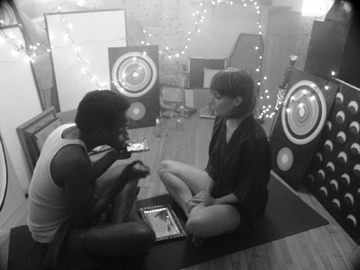
RavMon: The film is bookended with the scenes involving an anxious older couple at the dining table. Are these worried parents? Are they redeemed at the end or is their daughter, and if so, what from?
Jeremiah: The photography of Gregory Crewdson often shows nervous families sitting at dinner tables, gripped in some kind of unspoken tension. Those pictures inspired me. In CONTACT, we see parents setting a table for three, awaiting someone coming home. The mood is ominous, as if they are waiting for a bomb to drop. There is a knock at the door, and they look up. As for what the characters feel when their guest arrives, and the meaning of the movie, I leave that up to the audience. The movie belongs to them now.
RavMon: Do you consider yourself a horror/genre director, or are you staying away from that label?
Jeremiah: I love horror movies and would be happy to be considered a genre director. I’ve always loved the possibilities of scary films, and would consider THE TEXAS CHAINSAW MASSACRE as much of a classic as, say, HANSEL AND GRETEL. They both feature young people traveling into a strange, unexplored new world where nightmares happen.
RavMon: Which movies and stories led the young Jeremiah Kipp to pursue filmmaking?
Jeremiah: As a child, I liked to draw and paint. My grandfather would read me stories, so I started writing my own. I had a small career as a child actor. These were all rewarding creative pursuits, but when I was 12 years old my family purchased a camcorder to record weddings and family gatherings, and I saw that with the camera I could explore the visuals of drawing, the narrative of writing, and the performance aspect of acting—it was like finding home, and when you discover that you want to live there the rest of your life.
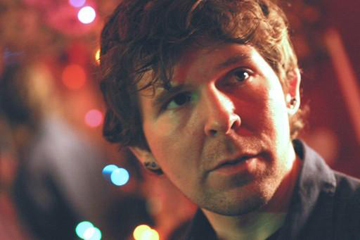
RavMon: Which directors are you most influenced by?
Jeremiah: I don’t own very many DVDs, so some movies I absolutely love (such as ROBOCOP, THE TEXAS CHAINSAW MASSACRE, ERASERHEAD, THE THIRD MAN, DIE HARD) aren’t even in my collection. But I have a number of films by John Carpenter, a couple by John Frankenheimer, an assortment of titles by mad cult directors like Andrzej Zulawski (POSSESSION) and Alejandro Jodorowsky (EL TOPO). I just watched THE CABINET OF DOCTOR CALIGARI again and was absolutely blown away. As for influence, it can come from all directions. David Lynch and Steven Spielberg are two of my favorites.
RavMon: Who’s your dream casting ‘get’?
Jeremiah: I’ve started a correspondence with Ken Foree, who we approached to be in THE SADIST. He didn’t feel he was right for it, and supported our casting of Tom Savini, but he’s been very supportive of CONTACT and CRESTFALLEN and suggested he’d like us to work together in the future. That’s something I look forward to very much. One of my favorite genre actors is Tom Atkins, who of course did fantastic work in NIGHT OF THE CREEPS and HALLOWEEN III, but was also pretty spectacular in a little-seen American Playhouse film called LEMON SKY as Kevin Bacon’s troubled father.
RavMon: What’s next for you?
Jeremiah: There’s a collaboration with actor Jerry Murdock (from I’LL BURY YOU TOMORROW) that’s on the front burner, as well as a project with producer Marv Blauvelt that would be shot in Indiana. It’s difficult to talk about movies before they’re fully realized, though. I have a monster movie script that can be made for a low budget that we’ll get into production. But my philosophy is to let the future come.
RavMon: Where can RavMon Readers catch THE SADIST?
Jeremiah: It’s in the hands of the producers right now, and the future of THE SADIST rests entirely with them. All I can say is, look for it in 2012.


